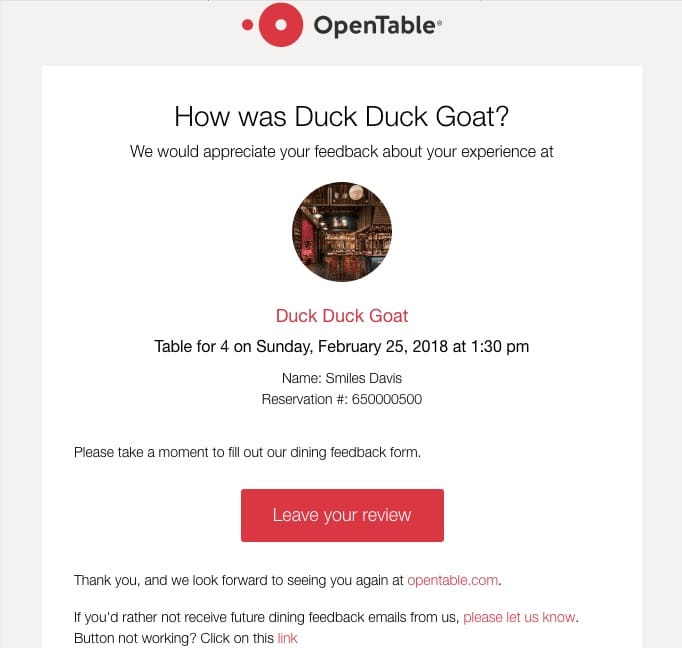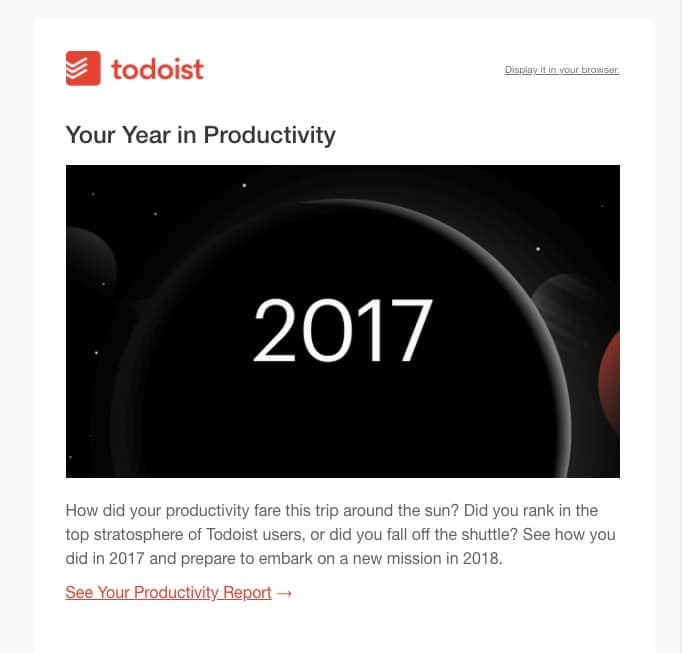Article first published December 2017, updated June 2019
What’s the first thing that comes to mind when you think of email personalization? Although the first thing that comes to mind is likely inserting a subscriber’s first name into the subject line, there’s much more you can do with personalization.
Personalization includes an array of awesome, data-driven techniques that bring in substantial ROI. These techniques include making recommendations based on past purchases, using dynamic content to fit consumer preferences, showing an understanding of purchasing history, and taking advantage of data to promote compelling offers.
Brands are using creative and diversified email personalization methods to increase brand engagement, foster customer loyalty, and, ultimately, work to please those 75% of consumers that are more likely to buy from a brand that personalizes messages.
Today, we’re sharing inspiring email personalization examples from 11 brands using email personalization like pros.
How do you personalize email marketing?
If you aren’t sure how to personalize your emails, check out these personalized email examples by brands that absolutely nail it.
1. Sephora leverages VIP status.
is killing it when it comes to drafting a personalized email. Of course, they use personalization in the subject line, but they take it one step further by including personalization in the content of the email. It’s just one extra way to say, “Hey Allie, we care about you and your makeup preferences.”
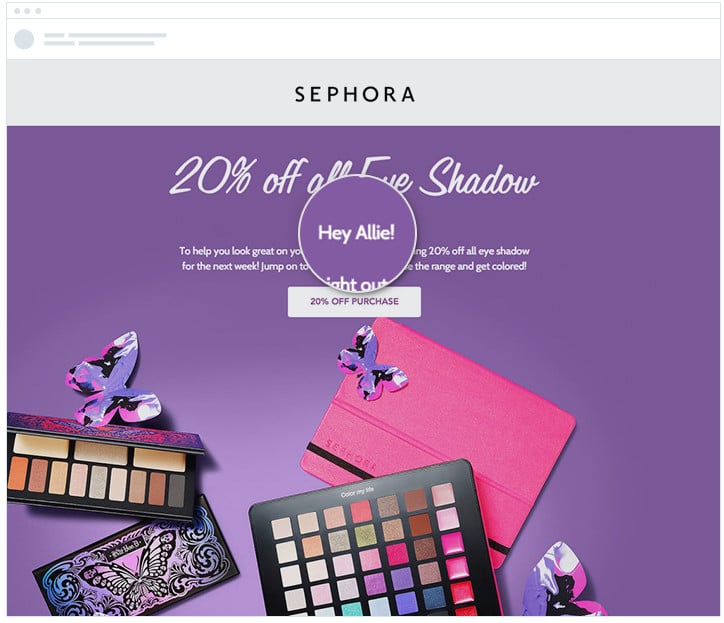
Personalizing email copy isn’t the only thing Sephora does well. They also set up rules and triggers to send personalized offers to reward members of their loyalty program.
For example, they use a VIP status as a trigger to send out more targeted offers to customers that historically purchase more online.
If the customer isn’t part of the loyalty program, or spends less than $200, then Sephora will send an email inviting them to see new skincare products.
2. Adidas segments their list based on gender.
is another brand that knows how to cater to their customers. Adidas has two primary markets that differ in the types of shoes they purchase. Those primary markets? Men and women.
Rather than sending a generic email to all customers with all their shoes, Adidas segments their lists based on gender. Then they can send an email highlighting hip, new men’s shoes to their male customers, and cute women’s shoes to their female customers.
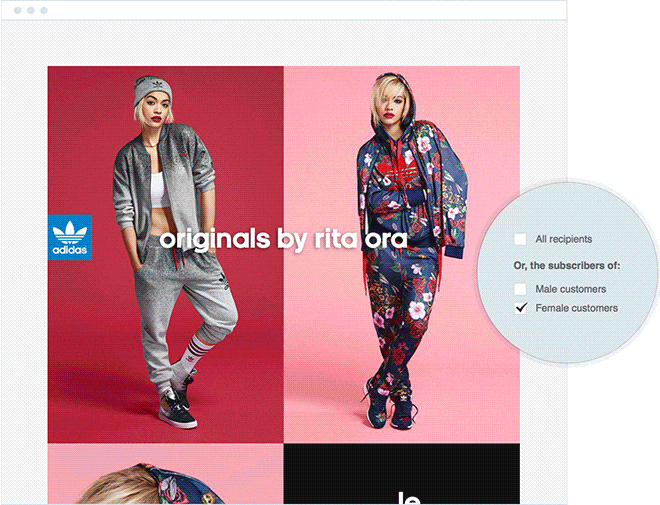
As a consumer, it’s neat to know your favorite shoe brand won’t bug you with promotions that don’t interest you.
3. easyJet tells a personalized story.
The easyJet 20th-year birthday celebration campaign has to be one of the most innovative and creative campaigns using personalization to date.
For this campaign, easyJet used dynamic content, links, and images to tell a personal story for each easyJet customer. Each customer received a unique email with personalized content that highlighted everywhere they’d travelled with easyJet in the past 20 years.
Take a look at the email Alex received.

Alex got a quick reminder of all 12 different adventures in eight different countries he experienced with easyJet.
Not to mention, easyJet offered him an awesome recommendation, Malaga, based on his past preferences. They topped it off with a call to action that works.
EasyJet also reported that their open rates from this campaign were 100% more than that of their typical newsletters.
4. Asics sends personalized follow-ups.
Wouldn’t it be great if you could act as a personal shopper and salesperson for each of your online customers?
You basically can, and Asics can show you how. Asics doesn’t keeps track of track their customers’ purchasing activity and then they leverage real-time marketing automation information to send personalized email follow-ups.
For example, if a customer puts something in their cart and then abandons the cart, for whatever reason, Asics will send a high-quality reminder email urging the customer to return and complete the purchase.
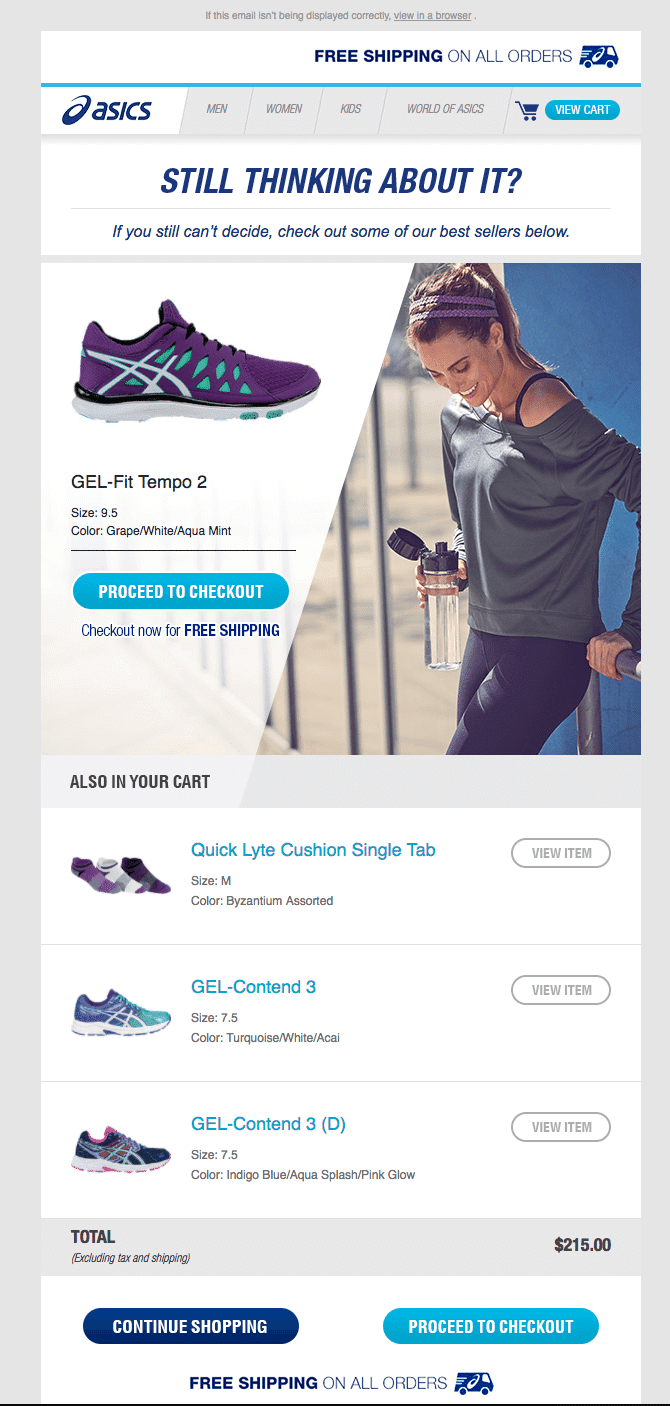
This type of personalization is what consumers want, and, with cart abandonment rates at an all-time high, adding this to your marketing strategy will save your business a lot of money in lost revenue.
5. Flight Centre segments based on customer data.
As you can imagine, a travel company like Flight Centre has a diversified target audience, and sending out a generic email with all their flights and deals just wouldn’t be efficient.
So what do they do to combat this problem? They compile customer data from email, back-end systems, and social properties to create highly targeted segments. These segments are based on past purchases, customer preferences, interests, location, and engagement.
Flight Centre segments their lists and uses dynamic content so customers that are interested in traveling to the Caribbean get emails about the Caribbean, and customers interested in travel to Northern Europe get info about flights to Northern Europe.

It may seem like magic, but it’s not. It’s just smart use of behavioral data collection and dynamic content with a splash of creative copywriting and nice design.
6. Mack Weldon makes cart-based recommendations.
Personalization can be as simple as highlighting products you know your customers were previously viewing or making recommendations based on other purchases your customers have made.
Mack Weldon uses this technique in their email marketing strategy and it works wonders. They collect data on customers’ carts, and then send emails with recommendations based on what the customer already has in their cart.
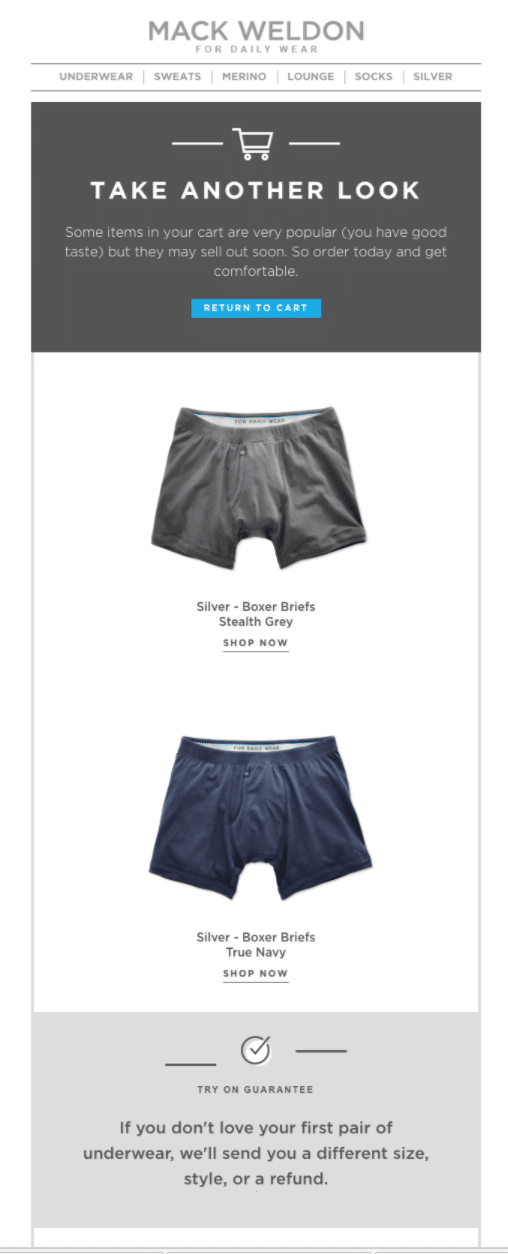
This technique helps remind customers to finish their purchase and encourages them to try more products they’re bound to love.
7. Nissan sends out custom maintenance milestones.
If you sell a product or service that comes with customer maintenance milestones, then personalize like Nissan.
Nissan keeps track of every customer purchase and then sets up different maintenance milestones. Once it’s time for a customer to bring their car in for maintenance, Nissan will send out an automatic reminder urging the customer to take care of their car.
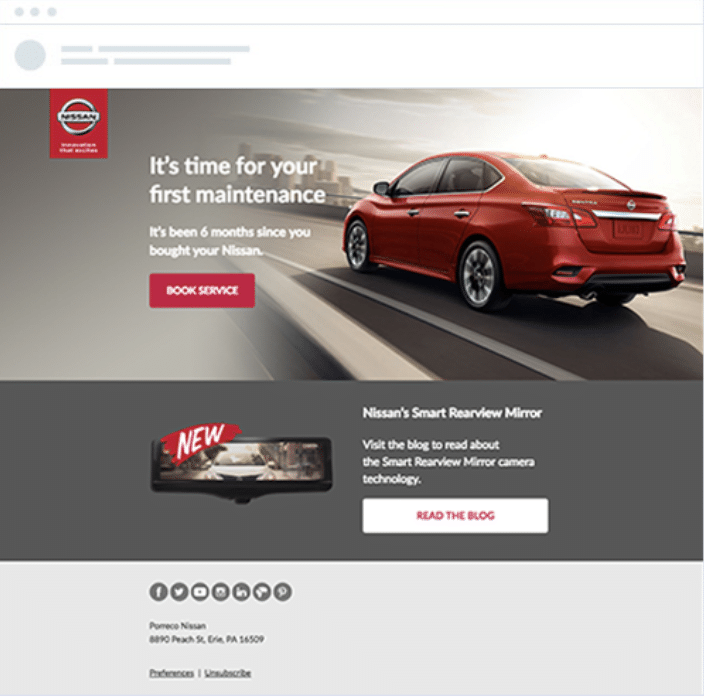
It’s difficult to remember to do things like get the oil changed, schedule your 60,000-mile maintenance, change your air filters, etc. How great is it that Nissan takes the time to remind customers, so they don’t have to remember? Plus, it increases the likelihood customers will take their car to the dealership for service, resulting in a boost for business.
For service-related industries, consider personalizing your reminders just like Nissan.
8. Monica Vinader personalizes images for maximum relevance.
Monica Vinader kicked up their personalization game with a subject line that read, “This season it’s personal” and goes for maximum relevance by not only including the subscriber’s name in the body copy of the email, but personalizing both images in the email with the subscriber’s initial. They can do this using dynamic content leveraging the first name data they have about their subscribers.
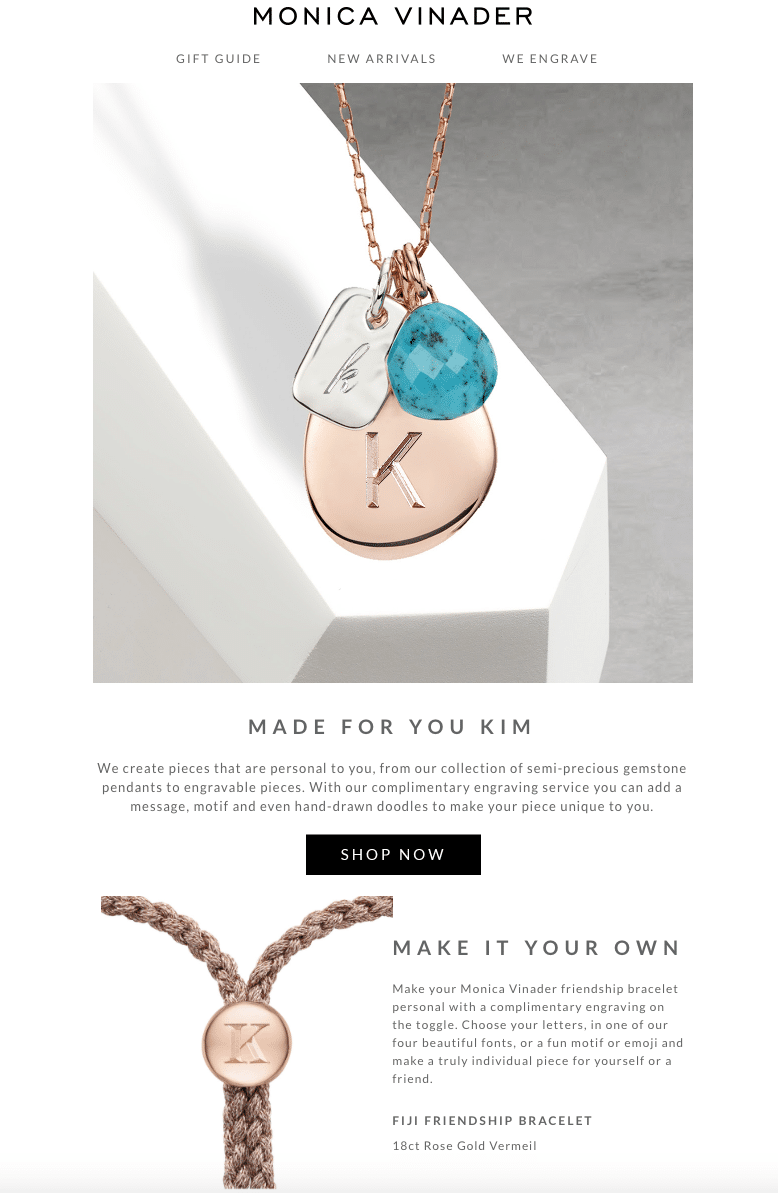
9. OpenTable encourages customer engagement with review buttons.
You probably already know that a call to action (CTA) is a vital component of your marketing strategy, but do you know how to add it to your content?
Adding a clear, actionable CTA button to your email will definitely improve your click-through rate. More importantly, it’s an opportunity for customer engagement, which benefits you in two ways.
First, when customers are engaged with your brand, they’re more likely to develop a sense of loyalty. That, in turn, can lead them to stick with your brand when making purchases and cause them to spread the word about your products or services.
Second, customer engagement often gives you a chance to gather more data about your customers. The more information you obtain, the more personalized content you can create.
OpenTable does a great job of this. Their CTA encourages app users to leave a review of the restaurant they just visited. This information will not only help other consumers know whether a restaurant is good or not, but it also provides OpenTable the information they need to make personalized recommendations based on each customer’s review history.
Source: Really Good Emails
10. Spotify appeals to their customer’s sense of nostalgia.
When it comes to creating a personalized email, Spotify has it down.
Spotify provides a customized listening experience based on the musical preferences of their subscribers. However, they also create a time capsule music collection for their listeners. Typically, this is music from the person’s teen years, when music tends to have a major impact on a person’s life.
Source: Really Good Emails
By creating these time capsules, Spotify is appealing to their subscribers’ sense of nostalgia. Why is this important? You don’t just want to attract the attention of your subscribers; you want to touch their heart.
Creating content that touches a person emotionally—as is the case with nostalgic content—will make them pay attention to what you have to say. When a person is more open to your content, you have a better chance of getting them interested in your products/services.
Plus, the warm, fuzzy feelings nostalgia produces will now be linked to your brand, which means your subscribers are more likely to open future emails and engage with your content.
11. Todoist looks at the big picture when creating personalized content.
One of the great email personalization examples is this one from Todoist.
Source: Really Good Emails
The reason this is such a good example of personalized email is that it reminds us not to forget the big picture. It can be easy to miss the forest when focusing on email segmentation and performing A/B tests. You have to remember, though, that there’s a very good reason why your audience was attracted to you in the first place.
In the case of Todoist, it’s because their audience wants to know how to improve their productivity. The task management company knows that people who use their app want to know if they’re making progress, which is why they send an annual productivity report.
This proves that understanding why people have subscribed to your email list can provide valuable information pertaining to your email personalization strategy.
Wrap up
These 8 brands aren’t afraid to go big when it comes to email personalization. By using customer names, utilizing dynamic content and images, tracking customer data, using rules and triggers, and segmenting lists, they’re able to provide customers with access to the exact information they want.
By following these email personalization examples, you can provide your subscribers with the relevant content they crave. In doing so, you’ll be able to improve your open rates and, ultimately, your conversion rates.
SaveSave

